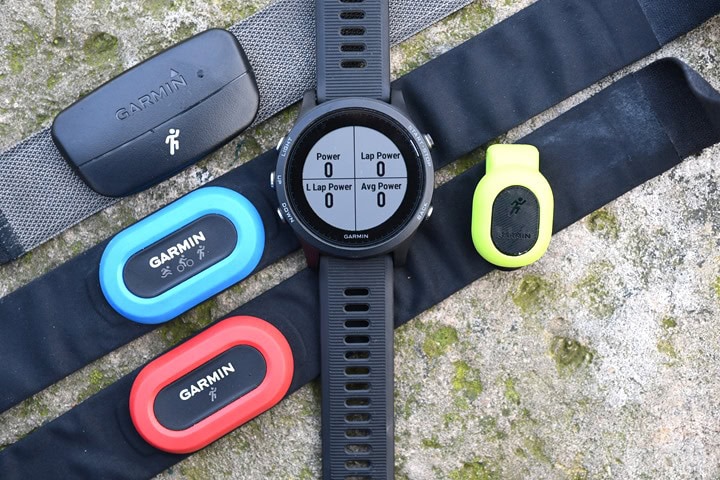
Today, Garmin released their running power app that they announced back in October. The functionality requires a Garmin RD-POD, Garmin HRM-TRI, or HRM-RUN strap. It also requires the latest Garmin watches, specifically either a Fenix 5, Chronos or a FR935.
While Garmin might say otherwise, the reality is that it’s meant to compete with both Stryd and RunScribe running power. And in many ways it does. If you’ve got the required watches and sensors listed above, then it provides equally as unverifiable numbers as those companies do.
I’ve been using it since October, and more lately also in conjunction with Stryd and RunScribe Plus, both of which provide running power to Garmin watches as well as competitor watches. So I’ve got a pretty good idea on how things work, but at the same time, it’s really something best visited again after many months of usage on final products – such as next spring.
I’m going to change things up a bit for the format for this post, if for no other reason than I’m feeling the need for speed…err…difference? Let’s move on.
The Good:

The first thing you’ve gotta do is get the app installed on your device. The good news is this is silly simple, and is just like installing any other Connect IQ app. Technically speaking, the Garmin Running Power is actually a multitude of apps, and even further, it’s actually a data field, not a full-blown app. But that’s actually all good stuff – because it gives you way more flexibility. All of these are currently published from an entity called ‘GarminLabs’, as opposed to Garmin itself. Likely this is Garmin trying to taper your expectations that this is all a bit new. Here’s the full list of what’s available:

The titles might be a bit confusing at first, but it’s pretty easy. Here’s the five apps you’ve got:
Average Running Power: Running power average for the entire workout
Combo Running Power: Current power, lap power, last lap power and average power on a single data page
Lap Running Power: Will show running power for your current lap
Last Lap Running Power: Will show running power for the previously completed lap
Running Power: Will show instantaneous running power
Like with cycling power, there’s a bit of volatility in the instant power number. Like others in running power, Garmin has done some smoothing here to make the numbers easier to follow – but I still find it pretty variable. As such, I kinda recommend one of two options: Lap Running Power, or the Combo Running Power.
With the ‘Lap’ option, you’ll get a single data field that you can place on any data page alongside other data fields (such as heart rate, pace, time…whatever you want). Any time you press the lap button like normal, it’ll keep the average for that lap as what you see. This is great for doing most interval workouts, since your ultimate goal for any interval workout should be the preset target (be it pace, time, cadence, etc…). It’s no different with power.
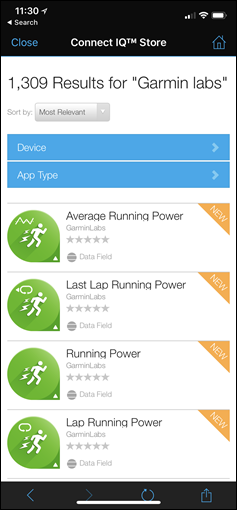
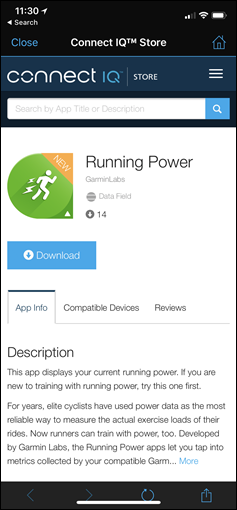
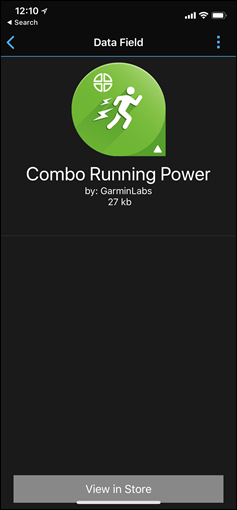
Alternatively, you can use the combo data field, which gives you ‘All the powers’ on one page. This is great if you want a dedicated data page to running power.

Now, remember that Garmin’s Running devices are limited to two Connect IQ data fields being active at once. You can install additional fields on your device, but you can only have two active in a workout at any point in time. And even further, you can’t reuse one of those fields on multiple pages. That limits you a bit.
For example, in my running setup, I’ve historically had heart rate (HR – Current) on almost all my pages. Some pages are dedicated to lap stats (except HR, which is always current for me), while others are totals (I.e. total run time/distance/etc…). I can’t set up 4 pages and put power on all of them, it can only be in two spots.
Now remember, before you start running, you MUST put at least one of the Running Power data fields somewhere on your run screens, otherwise it won’t record anything. It’ll record the same data no matter which one you put on there (since it’s just varying views during the run, the underlying data isn’t impacted). Simply go into your data field settings on the watch and you’ll find these fields under Connect IQ:

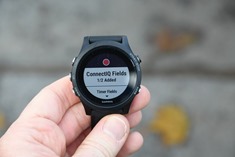

With all that said, we’ll sit for 10 minutes.
Actually, you don’t really have to – unless you’ve been following this guide and truly do plan to go out and run immediately.
See, Garmin actually pulls wind data from nearby weather stations. In order to get the data to your watch, it needs to ensure it’s been connected to your phone at some point in the last hour for at least 10 minutes with the Garmin Connect Mobile app enabled somewhere in the background. If you use your watch as a general smartwatch, then there’s no issues here – it’s connected 100% of the time as it uploads steps and other metrics constantly anyway. If however, you don’t wear your running watch all day, then just put it next to your phone while you get ready.

With that set, be sure that you’ve got your HRM-TRI, HRM-RUN, or RD-POD connected/enabled. Remember, you need one of these (the one in the back is the older HRM-RUN with the runner man icon on the front):
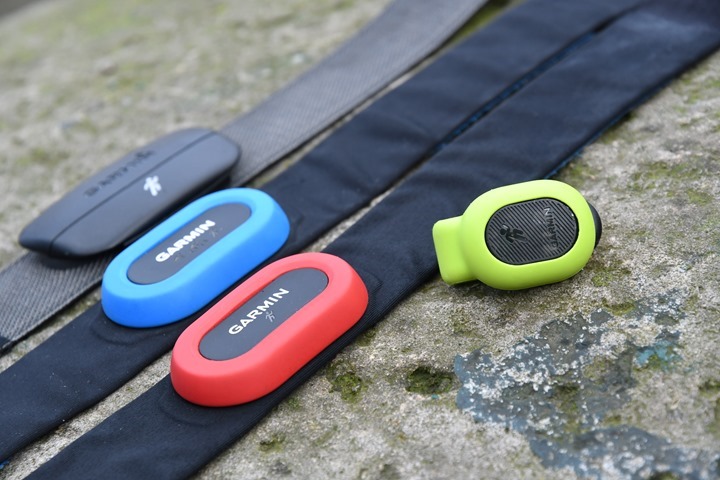
So now we’d head out for a run. While running we’ll see a power number on the watch as we’d expect.

In general, with Garmin’s running power algorithms, this number will be higher than your cycling power for the same effort (by a fair bit). This is neither right nor wrong. It just is. Despite how much, as logical humans, we want these two to match, there’s actually no scientific or mathematical basis for them to match. As with all things matching (clothes, musicians in an orchestra, manhole covers with yellow lines painted atop them reinserted the right way after servicing), nice doesn’t mean real.
Now there are some caveats here. For example, you can’t set any power targets in a custom workout, though you can create zones to show within the settings (as well as set basic high/low alerts using the CIQ app configuration). But neither of those have the same flexibility as a native data field like heart rate. There are other quirks as well like you won’t see running power metrics in the totals at the end of the run, nor in history on the device.
Note that Garmin has confirmed they do leverage secondary speed sources within the algorithms. So for example, all of their current running watches are using wrist-based accelerometers to help taper pace against GPS pace oddities (just as Suunto and others do). Garmin declined to specify to what degree exactly, but this helps against GPS pace blips. If you have a footpod, it’ll use that as the pace/speed source.
Anyway, you’ll run your run and get power along the way. Once complete, you’ll see running power on Garmin Connect down in the Connect IQ sections:

You’ll also see it on Garmin Connect Mobile too:
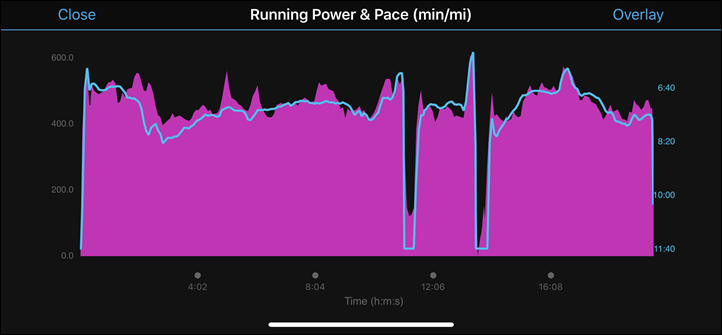
And then that data is stored within the .FIT file so that 3rd party apps can access it. Though, it won’t show up as ‘power’ in most 3rd party apps. Instead, those apps have to be coded to understand that specific Connect IQ app and the data from it.
But overall, the concept of running power in Garmin’s apps works fine from a functional standpoint. But let’s talk a bit about where things are messier.
The Bad:
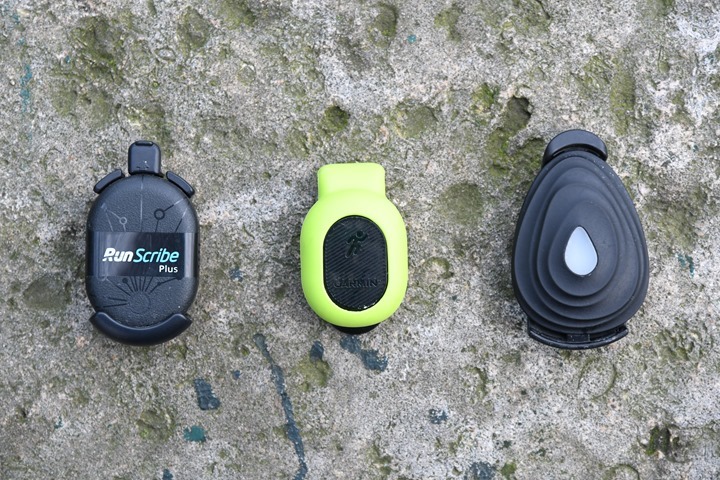
It’s probably a bit harsh to label this section ‘The Bad’. But ultimately, that’s sorta what it is. But if you’re skimming, don’t mistake this section as saying ‘Garmin is bad, Stryd & RunScribe is good’, as that’d be a flawed takeaway. Instead, it’s me saying “The whole situation is….squishy.’
And by ‘situation’, I’m referring to whether or not these numbers are accurate. But it’s not just Garmin, rather, everyone. See, the first thing to understand about running power is that with the exception of Arion, all these companies are using accelerometers and gyros to calculate running power. Arion is using pressure sensors in your insoles (shoes) to more directly measure it, but even that has caveats around shear forces.
(Side note: I’m not using Arion running power data here because at present it’s too messy to collect, normalize, and graph. Until they roll out some planned features in that area, I’ll be holding off a bit.)
So anytime we hear the word ‘calculate’, we have to understand that not all calculations are equal. Just like when different watches produce different calorie calculations, the same is true here. Different companies all have equally smart people, and those people sometimes disagree on what’s truly correct. No different than employee disagreements at your workplace, or between your company and your competitors.
And in this case, it’s not just the companies disagreeing – but also scientists too. Depending on which study you use as the basis for your device, you’ll get different results. All of which temporarily ignores those in the science community that disagree with running power as a concept at all.
So – a more interesting question might be how they compare? After all, with Stryd, RunScribe, and Garmin all out there producing power data, how might an overlay look? Glad you asked, and here ya go (sorry, the automated colors are a bit hard to see on this one, I’ll try and get that fixed shortly):

What you’re looking at above is a comparing of Garmin Running Power, Stryd Running Power, and RunScribe Plus Running Power. It doesn’t take a rocket scientist to see they don’t match 100%. They do trend together though for the most part.
At first, one might presume a given one of them is incorrect (or correct), but here’s the thing – none of us can say that. In fact, nobody can. Anyone who tries to say that has an agenda here. There’s simply no technology at this point that can account for everything that can give ‘known good’ outside.
But the key word there is ‘outside’.
See, part of the challenge is accounting for two very specific items: Wind and terrain (specifically things like gravel, sand, etc…). Only Garmin can somewhat account for wind, and none of them account for terrain. So if I’m running into a headwind for an entire one-way marathon, then most of these technologies won’t account for the added wattage – it’s as if the wind doesn’t exist. Garmin’s running power, in theory, does by using wind stations nearby, and that likely would have actually worked well for my marathon since it’s mostly wide open terrain. But in the swirling winds of the city I live in, that falls apart somewhat.
The next is terrain, for which none understand that it requires more power to run on gravel, grass, or sand than it does perfect pavement. For road runners that won’t be a huge issue, but for trail runners it’s mostly a non-starter.
Here’s another longer run, with both hills as well as tunnels (since that shows how Garmin transitions from GPS to wrist-based pace).

The above was relatively steady-state, though you see a fair bit of variability within Garmin and RunScribe that you don’t see in Stryd.
Next, let’s look at a set of intervals. This was about 10 days ago, and thus on non-final Garmin (or even RunScribe) software. The biggest thing I’ve seen change is that it’s a bit more smoothed than this on the Garmin side (as you see on all the other plots):

In the above run, I did 10 minutes of warm-up, followed by an increased pace for 5 minutes. You can see that fairly clearly above on all three units.
Then I did 4x90s on/off at roughly 5K race pace. You can see that that same pattern exists where Stryd is lower, and RunScribe and Garmin higher. What’s notable here is that from an effort standpoint Garmin/Stryd was more in-line with expectations (in terms of jump of power).
This is then more pronounced towards the last four sets (at 60s each) whereby I did two at about an 800m pace, and then two closer to flat-out. When we talk flat-out pace, these numbers jump again for Garmin, akin to what I’d expect. Stryd stays more flat, and RunScribe actually dips a bit. I don’t know why.
The cool-down sees more separation again. Remember again though that this was on beta above, so things do change a bit.
So how about inside? Glad you asked. I tried that out too! Here’s that:

In this simple test, I started off and did 2.5 minutes at 10KPH, then 2.5mins at 12KPH, then 2.5mins at 14KPH, then 1 minute at 16KPH and 30 seconds at 18KPH. You can see that Garmin starts much higher than Stryd, but as I get into my groove (at 14KPH), then RunScribe and Garmin are near identical. They also track closer up higher.
But wait you say – what about all the studies they reference saying each is right? It’s true, each company references different studies:
Stryd: Just yesterday, Stryd published this 16 page study showing how they compare to a high-end force plate treadmill. And I applaud them for doing that. Nobody else has yet. But it’s also highly misleading, since it’s inside. Most of us don’t compete in races on treadmills, but rather go outside where complexities like wind, terrain, and even just general air resistance are where the issues are with this device.
Garmin: Within their large running power FAQ page they list a huge number of scientific papers that they use for the basis of their calculations. Like with Stryd, I too appreciate the clarity there. Though, it’s a bit of a needle and a haystack to sort through as to what exactly they’re doing.
RunScribe: They’ve not only listed published papers, but also even listed the exact algorithm they’re using via a nifty calculator that you can play with. Further, they’ve provided boatloads more information in their forums. Out of all the approaches, I’d say this is the closest to what I’d like to see, though I’d love to see them also validate indoors as well (despite the caveats to indoors vs outdoors).
So about now you’re wondering whether or not each device is consistent to itself, and the answer is: Sorta.
I think Stryd is most consistent to itself from what I’ve seen (whether or not it’s accurate I don’t know). I think Garmin is more volatile than the others, but also seems to more accurately capture sprints in terms of perceived effort (again, regardless of the specific number). And RunScribe is somewhat in between; it’s tamer than Garmin’s volatility, but still seems closer to Garmin’s numbers.
Could you train by one given set of numbers? Perhaps. It brings up the always present issue though of what happens when you shift power meter providers. Heck, even when I switched from Stryd’s chest strap to the running footpod sensor, my numbers shifted. Some would argue that’s because placement is different (even between Garmin vs Stryd/RunScribe), and that’s true – but I’d also argue it shouldn’t substantially matter if we want to say running power is anything approaching semi-standardized.
Side note for prospective DIY testers: Do ensure that if you’re comparing multiple running power meters that your weight is correct and identical across all devices/sensors and watches. It’s critical. On some of my earlier runs from a month or so ago I think there were some differences in weights which may have impacted things. All runs in this post are showing identical weights on all devices.
Also, in case you’re wondering how I created these graphs, back a few months ago the DCR Analyzer got updated to handle .FIT developer fields, which is where the data from all these apps gets recorded into. This allows you to mix and match any developer fields and overlay them. You can even do the same thing with the DCR Analyzer if you have two or more of the running power devices. Remember that Connect IQ limits you to two fields active during a workout, so in my case I had to use two watches to get coverage of the three fields. If you only are comparing two devices, you can do it on a single watch.
And the Ugly:
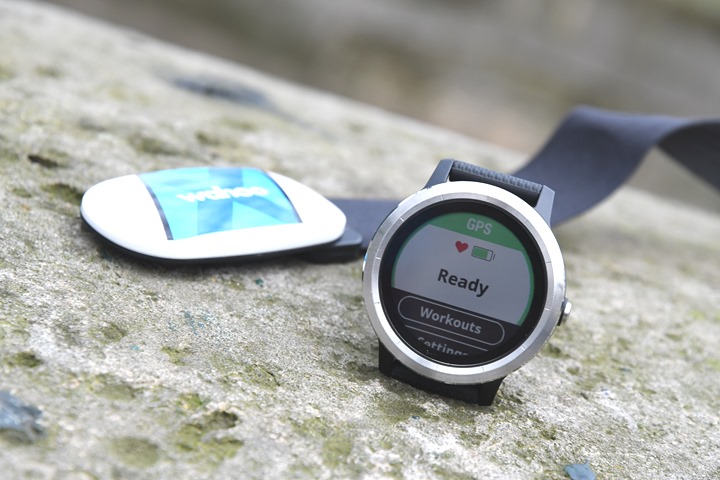
So what’s ugly? Well, not actually the accuracy. Because as I said above – you can’t verify that. Nobody really can outdoors. Indoors, there’s some possibilities there, but even with that there’s disagreement in the scientific community on what the definition of running power should be.
But that’s actually not where things get messy. Rather, it’s on what devices it supports (or doesn’t), as well as what devices it may support in the future.
(Preemptive note #1: Some of this might get geeky, but I think it’s important to understand, and important to call Garmin out on this.)
(Preemptive note #2: Most of my annoyance here isn’t actually the power app itself, but how Garmin is doing things around it. Effectively, this is a proxy war and the Garmin power app is the bystander.)
See, as you remember, the Garmin Running Power app has three specific requirements:
A) Must have a barometric altimeter
B) Must support Garmin Connect IQ 2.4
C) You must have a compatible Running Dynamics sensor
At first glance, item B is the only one that’s moderately annoying, because that excludes the Fenix 3/3HR, as well as the FR920XT. The main reason for the CIQ 2.4 requirement basis is that Garmin wanted to leverage the new standard ANT+ Running Dynamics profile that came out earlier this year, which would be baked into CIQ 2.4.
But here’s the thing, the above is actually full of hidden caveats:
A) Must have a barometric altimeter*
B) Must support Garmin Connect IQ 2.4**
C) You must have a compatible Running Dynamics sensor***
Here, let me help you:
A) * – “We actually mean a device with a barometric altimeter and its name is Fenix 5, Chronos, or FR935”
B) ** – “But only if that CIQ 2.4 device is named Fenix 5, Chronos, or FR935, Vivoactive HR/Vivoactive 3 need not apply even though it has 2.4”
C) *** – “But only if that ANT+ Standard Running Dynamics device is made by Garmin, not Wahoo or Stryd or anyone else who adopts the new standard.”
And items #B and #C are a bit of a backtrack in how Garmin has handled standards previously. After all, the entire point of having standardized Connect IQ versions is to have uniformity for developers to aim towards. Garmin says that #B was more of a miscommunication, and I can kinda see where that occurred, but it doesn’t change the resultant: I disagree with how it’s being implemented.
Let’s look at that CIQ 2.4 requirement first. For that, Garmin had stated this was the CIQ level needed because they wanted to leverage the new Running Dynamics built into it. That’s a laudable goal, as it forces Garmin to utilize that pipeline of information. The downside though is that it makes it unavailable to previous Garmin units, specifically the Fenix 3/3HR and FR920XT – despite those units natively supporting Running Dynamics already. In theory, CIQ 2.4 should have made the running dynamics pieces available to any CIQ2.4 device, so even something like the Vivoactive 3 or Vivoactive HR.
Except Garmin didn’t do that. They decided not to roll out that feature to the ‘lesser’ watches, despite being totally capable of it. And certainly, that’s their right. Product differentiation and all. But it’s also an obvious developer double-standard that we haven’t really seen before. It says Garmin will only roll out Connect IQ developer pieces to devices as it makes sense for their own business. Again, that’s also their right. But it also undercuts the premise of having an app development platform where aside from specific hardware limitations (storage/performance/altimeters/etc…), all devices are treated equally. That’d be no different than Apple saying certain API’s are only available on the iPhone 8 Plus and not the iPhone 8 (or iPhone 6 vs 6c), merely because you paid more for that device. Rather than because there’s a physical hardware requirement.
But it gets better. Garmin then added that requirement #C:
“C) You must have a compatible Running Dynamics device***”
At first glance, that’s a perfectly understandable requirement. Today, that basically means a Garmin RD Pod or HRM-RUN/HRM-TRI strap. It needs the additional non-wrist based accelerometer data, just like other running power meters do. That’s perfectly fine and logical.
Except for the catch: Garmin’s requiring that it be a Garmin branded device (aka RD-POD/HRM-TRI/HRM-RUN).
Why does that matter?
Because Wahoo has stated their intent to support the previously established ANT+ Running Dynamics standard that Garmin is supposedly leveraging here. And other companies have shown interest as well. After all, that’s sorta the entire point of creating a standard – to have other companies adopt it.
But Garmin is saying that doesn’t matter. Instead, only if the ANT+ Running Dynamics device is made by Garmin will it work with Garmin Running Power app. Garmin says that’s because it depends on the quality of the data, and it needs high-quality data from Garmin’s own accessories. Except, there aren’t any devices sending out that data yet, so it’s a bit premature to say they’ll be any less accurate than Garmin (in fact, they could be more accurate). Furthermore, if that rationale held true, then shouldn’t Garmin block all 3rd party sensors? After all, it doesn’t block 3rd party ANT+ heart rate straps which are used for lactate threshold estimation in running, nor does it block 3rd party ANT+ power meters which it uses for FTP estimation. Nor does it block those sensors for feeding data into the recovery metrics.
So why do I care about this? Because Garmin is basically trying to get credit for using Connect IQ to develop this versus doing it natively. When in reality they’re leveraging cards they hold elsewhere to influence the end results – specifically which devices this does or doesn’t work with. None of which impacts the functionality of those lucky enough to have the required hardware, but otherwise prevents plenty of people from trying it out.
Wrap Up:
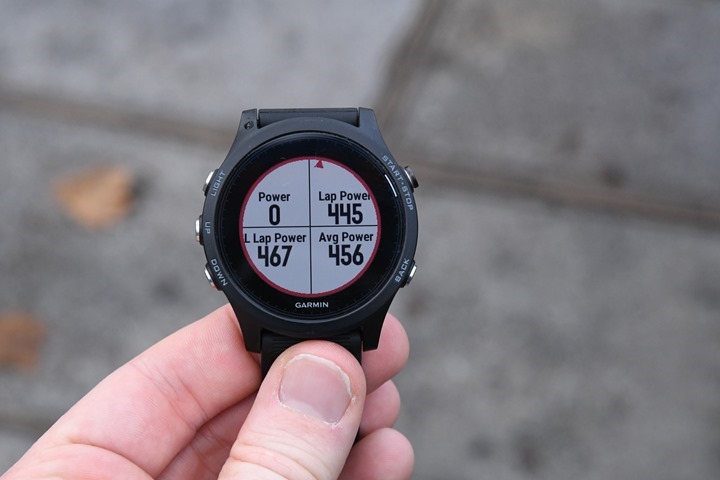
Here’s the thing: If you’ve got a Fenix 5, Chronos, or FR935 watch, along with an HRM-TRI/HRM-RUN/RD-POD, there’s no harm in loading up the app and sticking the data field in the background on one of your data pages. It’ll silently collect running power data for you, even if you never look at it. Perhaps a few months down the road you’ll look back and figure out some trends.
Or perhaps you’ll find value in it today. Just as people find value today in Stryd and RunScribe Plus. All of these have their pros and cons. Despite how some people might view it – I don’t see it as a case of a tradeoff of price versus accuracy. Rather, I think it’s more about different options that happen that vary in price with different features.
The real question may be where running power goes from here. An ANT+ working group has been established, and various players are operating within it to establish standards and definitions. That may be part of the first step to getting some consistency between the players.
And like with Stryd when they first started – I wouldn’t be surprised to see some shifts in power numbers from all the players over the next year, both in terms of algorithms as well as definitions of different metrics. Either way, it’s kinda like being in on Bitcoin from the beginning. It’ll be an interesting ride and you’re likely to learn some cool stuff along the way. Though, unlike Bitcoin, you’re not gonna get rich here. Actually, it’ll probably cost ya money.
With that – thanks for reading! Oh, and if you do some charted comparisons, I’d love to see those dropped below!
FOUND THIS POST USEFUL? SUPPORT THE SITE!
Hopefully, you found this post useful. The website is really a labor of love, so please consider becoming a DC RAINMAKER Supporter. This gets you an ad-free experience, and access to our (mostly) bi-monthly behind-the-scenes video series of “Shed Talkin’”.
Support DCRainMaker - Shop on Amazon
Otherwise, perhaps consider using the below link if shopping on Amazon. As an Amazon Associate, I earn from qualifying purchases. It doesn’t cost you anything extra, but your purchases help support this website a lot. It could simply be buying toilet paper, or this pizza oven we use and love.









































Ray,
You say “the one in the back is the older HRM-RUN with the runner man icon on the front”
Does this older black one with the runner man work? That’s what I currently have!
Yup! You may need to make sure it’s been updated at some point in the last few years (I think the last notable update was like a year ago), but if you regularly use your watch with it, it does it automagically for you.
I personally tested with a combination of the RD-POD and HRM-RUN, and I think one run with HRM-TRI.
Nope, unfortunately, it doesn’t.
Sorry, thought that the old band did not have the proper sensors but who else than DCRM to certify if it works or not
If you want a second confirmation, I have two of the gen 1 HRM Run straps (one came with my Fenix 2 and the other with my Fenix 3). I’ve just been out for a run with the older of the two paired to my Fenix 5 and the Garmin Running Power worked as it should (whatever ‘as it should’ means when it comes to runnning power….). So, yes the older HRM Run straps (detachable pod versions) do work with the Running Power CIQ DF app.
AFAIK if you can get running dynamics then it can work. However what device are you using it with?
Nice review ! I will test it tomorrow to see the numbers !
“So for example all of their current running watches are using wrist based accelerometers to help taper pace against GPS pace oddities”
That’s interesting. That suggests that Garmin can further improve GPS pace to provide a more accurate ‘live/instant pace’. So, putting power to one side, when do you think they will do that to improve INSTANT PACE to make it usable over a wide range of running scenarios? I kinda thought **they already were** doing that but what I see from Garmin’s instant pace…it isn’t accurate.
Yeah, I guess I’m wondering why different folks see different results there. I generally see actually really consistent pacing results when running (mostly city, but occasionally more bike-path style runs too). It’s not +/- 1-second type perfect, but within a 5-10s range at most.
Not sure if I’ve just gotten really good at pacing, or what (and this is across a ton of Garmin watches, none of which are from Garmin PR or anything).
I’ve only really noticed the wrist-based corrections when the GPS signal gets really bad. But in those cases, the wrist-based pace is still the only hope I have for usable paces, so I’m glad it’s there.
If I’m surrounded by skyscrapers my GPS-only pace, shown on Strava, thinks I’m doing 3 minute miles, but Garmin’s wrist +GPS pace will be fluctuating much less.
Agree with Ray. To me current pace (and in conjunction with lap pace) via GPS on current Forerunners is perfectly usable in most situations. Roll back a few years and would not have been so confident although lap pace alone has always been pretty good.
My 935 often has pacing oddities where it will climb up to a minute or two slower than I’m actually moving per mile for a while without obvious obstructions. It doesn’t happen at tempo run paces, only when I’m doing longer slow paces. My 220 was always spot on, though, and the 230 that I gave to my wife after the 935 was announced worked decently. I never understood the complaints until now, and I would be curious about getting a foot pod, but it does seem to be tracking the right time underneath, so it doesn’t really matter… in the moment I know I haven’t changed speed.
I notice that pacing seems to take a l-o-n-g time to recover after stopping. So, running along, pace seems good. Stop for a traffic light, pace goes to zero (fine). But then resume the same pace as before and I guess that it might be 40-60 seconds before the pace seems correct, starting from very slow after stopping (15:00 per mile) and increasing slowly to current actual pace (say, 8:00 per mile). This is a 920XT – maybe the more recent gen of Garmin devices are improved? My FR205 (!) resumes pace in this situation demonstrably faster than the FR920xt (one worn on each wrist, as a test). And I’ve had two 920xt devices (barometer flaw warranty replacement) that behave the same, so I don’t think that I have a particularly wonky device…
I was hoping they’d release the mythical 645 when this came out. I guess I’ll wait a bit longer
Really, power in running? So many assumptions, sketchy conceptual leaps, and approximations. And what for? What a waste of effort to arrive at a non-metric that is presented to us in the same units as the much more precise and reproducible cycling power metric, which is actually very useful for training and competing. *Yawn*. You really nailed it when you said, for running power “the whole situation is squishy”. If they quoted the running power in PsW (PseudoWatts) no one would be impressed. But that’s what the running power results are.
The concept of running power has validity, but today’s implementations have too many ways it can go wrong. We’ll get there, but it’s gonna take time.
Yeah, runners obviously expend energy, so there’s obviously energy per unit time = power. The big question is whether it can be accurately computed from accelerometers, barometers, and GPS. It’s much easier when there’s a bicycle involved.
But you might have said the same about cycling power if that was “new” today and nobody had experience of using it. Or indeed HR before that.I can see enough in the concepts to continue to experiment with it – I can slow down uphill or now even into a wind but still be putting out a similar effort with a similar number. Thing is running is a more “steady state” activity than cycling and you tend to find a natural rhythm anyway.
Thanks for the in depth review! I’ve been using Stryd for a week now, and after calibration, I’m finding it off by less than 1.9% consistently in terms of distance vs. measurement with a surveyor’s wheel for runs on the track, paved roads, and gravel trails. It’s on par with GPS in most situations and better than GPS when in forested trails/canyons. Once Stryd incorporates programmed workouts and calibration for its Apple Watch app, I will kiss my Garmin goodbye.
I agree with all your reservations regarding power. Therefore, I’m going to spend the next 18 weeks training for a marathon with Stryd power and see what happens. It would be great if some of your other readers can try power-based run training and see what their results are.
But if you only use a Stryd how do you know where you have been?
On Apple Watch, you have the option of turning on GPS tracking on in the Stryd app. It will still get all the power/distance/pace data from the footpod but will overlay the map tracks from the GPS data.
Ian. How was your training with power? Worth it? I mean does it really make the difference in training to have Stryd? Thanks
It worked for me, but that doesn’t mean power is a silver bullet. Success in running takes dedication and smart training.
Of course, you can excel without power; I assume almost pros don’t use it today. I was attracted to running power meters because it delves into the mechanics of running, and I think it’s a better pacing tool than is HR or perceived exertion. The insights gleaned from power meters serve in addition to all that we know about the aerobic/physiological aspects of training from more traditional methods. So, it’s supplimental and not a replacement for traditional methods.
I understand why many people question the way in which footpod power meters work (and thus their validity) but the fact of the matter is that the power = work/time equation can also be expressed as mass x acceleration x velocity. Mass is body weight x gravity. The last two variables can be very closely approximated with a 9-axis sensor and some smart algorithms.
Eventually, runners will embrace power meters just as the peloton has done. It’s your personal decision whether or not you have faith in today’s offerings. Ultimately you need to trust whatever training regimen you follow because if you don’t have faith in your training program, I think your performance will suffer.
A little confusion here. Mass is a fundamental attribute of matter; your weight is techincally your mass x acceleration of gravity at the surface of the earth. But we humans like to do things for our own convenience, so we interchangably use units of mass (kg) or force (lb) for our weight, because the acceleration of gravity at the surface of the earth is (roughly) a constant. (The statute unit of mass is called a “slug”, but no one ever uses it except maybe in freshman physics homework.) My Withings scale likes to choose it’s own units, so I never know whether it’s going to show kg (mass), lb (force), or stone (which I believe is defined as the weight of the number of pints a typical Englishman can drink at sea level and room temperature in one sitting, but I’m not sure about that).
Work is an integral, \int F\cdot dx (sorry for the TeX), where F = ma is a vector. Power is the time derivative of that (not just work/time). In very specific circumstances you can approximate that as mav, but not generally. If running power were as easy as using an accelerometer, it would have been done long ago and there would not be three (Stryd, Garmin, and now Polar) distinctly different numbers. Cycling power has the great advantage that you can isolate your measurements to the drive train , which has evolved to be very efficient (unless, like me, you use a PowerPod, which measures different things to get to the same result), and the force is applied smoothly and continuously to the road at a single patch. Not so with running.
Not that I’m all that excited about trying to use running power of any sort, I’m still kinda disappointed that the VA3 isn’t supported since I have and HRM-Run already and it would be a no cost feature to try.
Oh well, I’ll just sit back and see what the Forerunner update brings.
Any idea if Suunto plans on doing the same ?
I have their footpod and I’ve always thought that with a good algorithm, they could transform their footpod into a power meter ?
I don’t think their footpod has the right stuff in it to do that. However, their new little Suunto pod things could if they put their minds to it.
Also, do keep in mind that Suunto supported Stryd natively well before Garmin did.
Ray, that’s “shear forces” not “sheer forces”.
Funny, I actually had a tab open double-checking that…forgot to circle back from it.
Wellllll – poop. I was all fired up to get this app today for my VA3, and maybe head out and grab a RD-Pod, to see how this whole power thing with running would work. But nope, Garmin ham-strings the lower unit. Certainly that’s their right to do so, as you’ve said Ray, but doesn’t make me happy as a consumer, ESPECIALLY since the VA3 has the barometric altimeter. Grrrr oh well.
Ray, thanks much for this informative review!
I am going to try it our myself tomorrow.
Just wondered if I would be able to use both Stryd and Garmin Running Power (GRP) on the same watch and in a same run activity? Since the limitation of CIQ data fields can be using together is 2, I am assuming Stryd and GRP should play alone together fine?
And wondered at end of the run, which power data will be stored in FinalSurge and SportsTrack? Stryd or GRP?
Thanks!
Yup, you can use both at the same time. In fact, for most of my testing I had the FR935 running both Garmin Running Power + either Stryd or Runscribe. On the linked Garmin Connect files from today, I set it only for Running Power, merely to reduce confusion.
3rd party apps receive the .FIT file, which contains all the data. However, it’s up to that 3rd party app to show the data. By default, most apps won’t know to show the data. It has no idea if the recorded data is ‘Hamburgers’ or ‘Power’. It’s just random data to it.
Hi Ray, thx for your post. As a Sports data enthousiast I love seeing new Numbers coming in. Is there any way of getting the data into TrainingPeaks? Or
Is that one of the ThirdParty apps waiting for code adaptation?
@Sander
100% sure the data CAN be imported into Sporttracks desktip 3.1. this includes all the special metrics unique to RS. Same is true of Garmin Connect.
sportracks mobi, not sure (doubt it, yet)
golden cheetah, i think not yet. some of the metrics already exist in GC eg gct, vo but they dont appear to be populated from runscribe sources (just from hrm-tri)
TrainingPeaks I would guess would be same situation as golden cheetah
Is Wahoo getting into the act on sensor side or for watch/device?
Wahoo is already in the sensor business, they stated back this spring that they’d update the TICKR series to adopt the running dynamics profile. This past fall they re-confirmed they plan to do that, but not till early 2018.
I think Training Peaks does show running power from my Stryd at the moment. If I start using the Garmin app as well and so the file also contains Garmin power, which figure will Training Peaks use?
Only Stryd shows in my TP
My TP account shows my Garmin running power. I had another Power app source but it chose only one of them. I think it chooses only one source of data for each metric. Maybe it’s an option somewhere
Ray, thanks for your thorough review. Did you test for accounting for wind power OFF to see whether those numbers would be closer to Stryd/Runscribe?
Yes. Up until this week I was using the wind-off variant, and then this week I’ve been using the wind-on variant.
In general I don’t see much of a difference there, though it’s kinda hard to know 100%*. Fwiw, today was actually a really windy day (the 1st short run shown). Wind was set as on.
*Maybe down the road I’ll run two variants of the app on two watches – one with one on and one with wind off.
Thanks Ray, it certainly would be difficult to test for the real wind-on/off variant, as you would have to be real lucky to stumble upon an unusually windy day, plus the complexities of the two watches!
“*Maybe down the road I’ll run two variants of the app on two watches – one with one on and one with wind off.”
Think it partly depends what sort of runs you do. If say you do an out and back then many a time one way or the other feels harder because of the wind. There is a 10K trail circuit I often do which is sort of rectangular and largely flat. There has been times when have had to literally bend into the wind so would be useful to get some feedback on whether the inevitable slowing is a “problem” or not. Other times the wind may be lighter but still having an effect without really knowing it. If say the difference was 30W then that is very noticeable on the bike and presume in running too.
Me and a growing number of people I’ve seen rely on Stryd for accurate(r) pace. Much more accurate than GPS, than Garmin’s own pod and don’t even get me started on the in-watch accelerometer. I know this isn’t really the point of the review, but to me pace is a MAJOR selling point for Stryd.
Which is ironic as the main point power of is to stop you thinking about pace!!!
I’m seeing roughly equal accuracy & variability for distance and pace when comparing my calibrated Stryd to my Garmin 235 (GPS + Glonass) whenever there are no major obstructions. In all other cases, the Stryd is better. The exciting thing is that these footpods are getting good enough to get rid of GPS. This has a major impact on battery life. Of course, if you want those pretty tracks on a map…you have to turn GPS back on. Also exciting- you no longer need to make major sacrifices by a.) using the Apple Watch (or Android Wear in future?) for run training and rest-of-the-day use or b.) using a Garmin/Suunto/Polar as your smart watch for rest-of-day-use.
It’s more meant to stop you thinking heartrate….
Well I guess power is meant to be one number to focus on so probably an element of both pace and HR in running as I would look at both normally. Traditionally though runners have a target pace of x if say x falls because you go uphill you want some reassurance that you don’t need to push too hard to maintain the correct level of effort.
Nothing will ever take away the importance of pace for running. Running training depends in it like in nothing else especially the higher up you go.
Accurate pace is the most important metric that we didn’t have access to until now (we’ve had accurate HR for decades). GPS by comparison is simply not accurate (and “accurate enough for me” isn’t an argument).
It is accurate enough for me for sure! Generally I can now get auto lap km/mile splits within a few seconds of each other on long steady state runs if I put my mind to do so. I also always need to remind myself I was a far better runner before I ever strapped on a GPS device some 13 years ago although that is largely getting older. And in that anything like this I feel is good as it is just is one more to reason to put on my shoes and do a run to try it out.
It’s actually distance where Stryd wins, as it makes it far easier to track predicted finish time in a race if the distance is consistently accurate.
Andy,
are you are pro? because this argument about accurate pace is quite frankly silly. I don’t know how long you’ve been a runner but I have 30 years. No serious runner I know ( including pros) cares about instant pace for running. None. Pace is important in training but for most people (including pro close is good enough)
Why? because we simply never run at a constant pace when we are running, it’s impossible unless you are a robot. There are 100s of variables even on a flat surface that prevent people.
it’s funny People ran for tens of years without accurate pace and managed to survive.
Overpaying for a stryd pod just for pace seems dumb. you can get there with a far less expensive option. Many people don’t have $200 to waste.
Ray,
I ran with the power on my 935 this AM and did some efforts on the track at my 5k pace to try to guage “FTP” in some sense. Is there a way to export the file from Garmin Connect to TrainingPeaks so that the power data stays? Or is it only available to view in Garmin?
Data will be in the FIT file (you would not see it on GC either otherwise) so will be up to how 3rd apps handle it.
From what have seen so far Stryd and Garmin seem to compute VO somewhat differently. I am about 2cm “higher” on a Garmin for instance. Can you correlate the differences here to the power numbers especially given Garmin seems to be coming up higher? What about RunScribe? Given Stryd compute this at a completely different place to Garmin (foot vs chest or waist) is any real surprise they come out differently? Then there is the question of how exactly each company defines what they are computing. If these metrics are part of an overall algorithm to compute power ones assumes it is important to get this right.
I’d like some of those answers too Tim. I too find Garmin about 2cm higher. I have a suspicion that VO is one of the reasons why GRP has higher power numbers. Or maybe even THE reason. (GRP seems to have higher power variability in line with higher variability in GPS derived pace)
RunScribe does not, however, show or display VO. I would assuem they have some measure of that in their power calc but don’t know either way.
Its funny you guys are still here discussing this as if this is a precision instrument made by NASA. GRP is an algorithm of what someone thinks should be your running effort, nothing more. There’s some crazy math and some crazy assumptions, all polluted by variation, even if you wore the pod in a different manner. Attempts to using such models to make predictions of performance is laughable. I havent seen snake oil discussed in such scientific depth as this thread….go home ya’ll..
Ray, interesting review but not much evidence from your data charts. The power numbers vary, but only your indoor chart actually has an explanation what you did during the treadmill run, namely several intervals with increasing pace. In that chart it seems to me the Garmin data don’t correlate at all with those known stepwise increases in pace/power that you made. The other two show the same qualitatively expected pattern. It would be nice to see more charts with stepwise increasing pace, intervals, hills and the like in outside runs and then see if all three technologies at least qualitatively track those patterns. I’ve used stryd since August and while I of course cannot comment on the accuracy of the actual power, the patterns are very logical and reproducible. In that sense I feel you overemphasise how none of the suppliers can verify that their actual numbers are correct (and I agree with that), but fail to review which is better as a training aid. A bit shallow….
Freek
@Freek.
Yet as Ray notes STRYD ***HAS*** been validated indoors, I believe by an independent 3rd party. So in that scenario the others must be wrong. No?
[Repeat the same session outside and see what happens. If the 3x broad trendlines are comparably similar then you have to draw your own conclusions about indoor vs outdoors accuracy.]
I was hesitant to add in too many files from before the final version (which I got this past weekend). Both because things changes, but also because the wind aspect wasn’t included previously.
Still, to help for context, I added an interval run in I did above that shows some of the differences and what I was doing in the sets. Enjoy!
“Yet as Ray notes STRYD ***HAS*** been validated indoors, I believe by an independent 3rd party. So in that scenario the others must be wrong. No?”
Note that depends on which literature you use as your basis and how you want to measure it…
Most important sentence of the whole review:
“If you’ve got the required watches and sensors listed above, then it provides equally as unverifiable numbers as those companies do.”
Yep a good sentence if you want a reason not to bother trying Running with Power.
It’s good to see power coming to running. I really hope we can add this data along with HR to train better.
But to me, it’s just another gadget not backed up yet by a good and serious data analysis software/app. We literally accumulate loads of data every year but the software industry doesn’t propose real solution in analyzing that. We can see it with SportTracks dying for example and most of the apps (strava…) giving no much more analysis than a good ole’ notebook or spreadsheet can offer.
Big Data Holds Great Power, But Only if You Know How to Mine It” A. Guess.
Try Wko4 – for analytics software, and get some value from this data! You decide how and what to look at and dig into.
The vivoactive 3 does have a barometric altimeter: link to buy.garmin.com
Seems $249 is not expensive enough to support it
While I do love my Garmin watch – I think Garmin is being overtaken slowly by Apple.
Garmin owns ANT+ – and I do understand the benefits of ANT+ vs Bluetooth sensors.
But there is so little openness from Garmin. Garmin has the “We are the best” attitude at the moment – that attitude has killed a lot of products and companies. It almost killed Apple once before (but have they learned – no..)
Now Apple is out there banging on doors to get things compatible with their watches.
Where is Garmin? Locked up in their HQ considering how to lock their system in to get more sales. Lets pretend to open up ANT+ standards – but then make new things closed to our own hardware. By doing that Garmin is effectively telling ANT+ 3rd party developers to f…. off..
End result – ANT+ will go away – and BLE will win.
Wake up Garmin or you will be early for your funeral.
When you OWN a standard you should be out there getting SUPPORT for it EVERYWHERE. You should SUPPORT the companies making ANT+ sensors and EMBRACE them and help make them great so YOU will sell more as the end result.
ANT+ should have been the standard for Gym cardio gear – but now Apple just twisted the knife with their brand new Gym API’s with manufactures promising support for that before ANT+
Garmin for f. sake – WAKE UP.
yep you can already use STRYD to run with power on the apple watch.
Garmin do support both co-existence of BLE and ANT+ sensors on higher-end watches.
DC will probably correct me, but my undrstanding is that ANT+ is pretty cheap for companies to comply with to use in their sensors.
I think most triathlete/endurance readers of this blog would prefer ANT+ over BLE. Fro the gym crowd maybe it’s the other way around.
Having said all of that I suspect BLE will eventually be the dominant standard but NOT in its the widely used current VERSION of BLE.